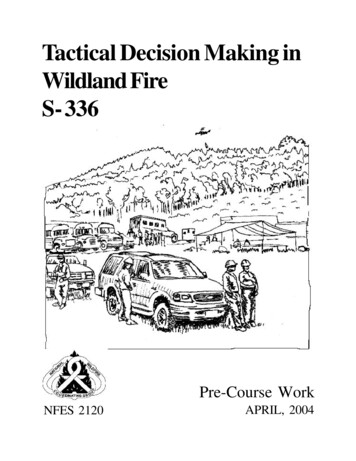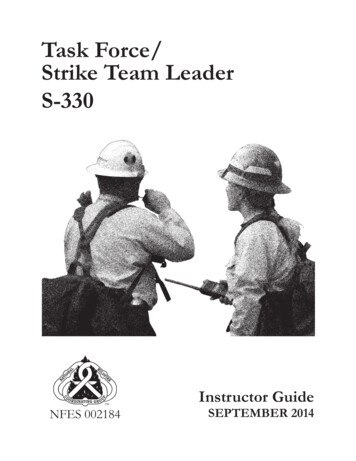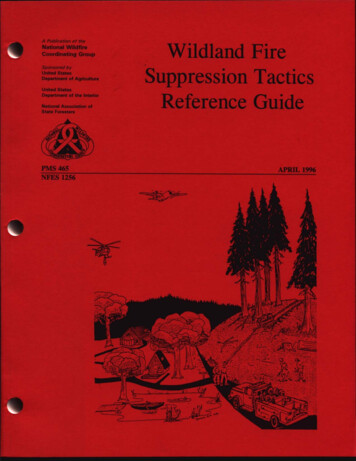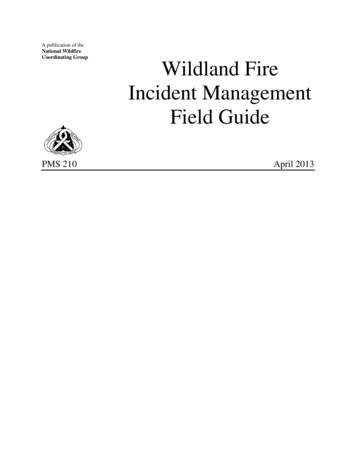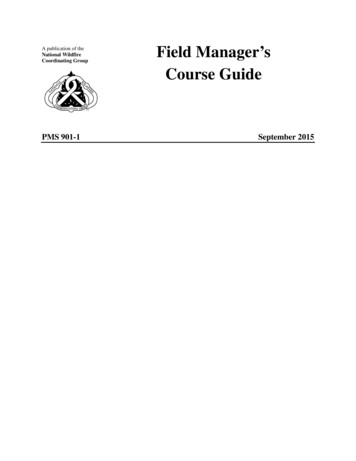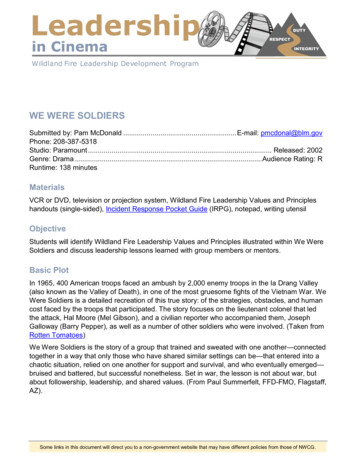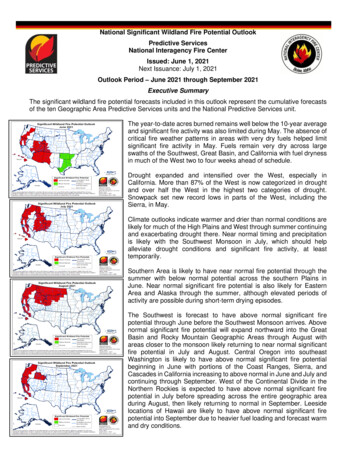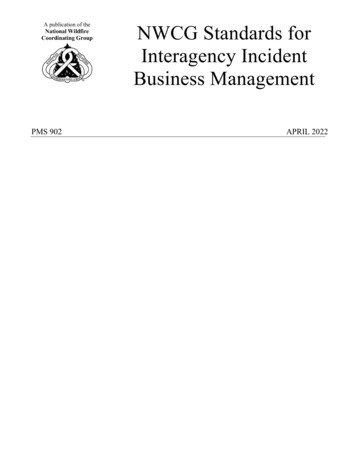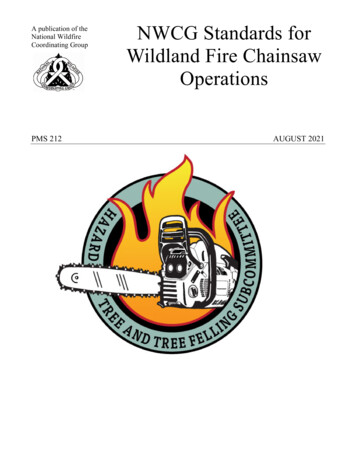
Transcription
A publication of theNational WildfireCoordinating GroupPMS 212NWCG Standards forWildland Fire ChainsawOperationsAUGUST 2021
NWCG Standards for WildlandFire Chainsaw OperationsAugust 2021PMS 212The NWCG Standards for Wildland Fire Chainsaw Operations establishes national interagencystandards for chainsaw operations on wildland fires. Meets or exceeds all Occupational Safety and Health Administration (OSHA) 1910.266 LoggingStandards. Ensures that risk management is incorporated into all aspects with an emphasis on opencommunications. Promotes safe and standardized chainsaw methods, techniques, and procedures for chainsawoperators from participating agencies. Provide consistent interagency guidance, common terms, definitions, and standardizedprocedures for wildland firefighting chainsaw use. Provides a standardized framework for current and future chainsaw training curriculum. Includes optional crosscut saws in Appendix A. Member agencies have agreed to meet or exceed the standards found within this document forcertification of sawyers.The National Wildfire Coordinating Group (NWCG) provides national leadership to enableinteroperable wildland fire operations among federal, state, tribal, territorial, and local partners. NWCGoperations standards are interagency by design; they are developed with the intent of universal adoptionby the member agencies. However, the decision to adopt and utilize them is made independently by theindividual member agencies and communicated through their respective directives systems.
Table of ContentsChapter 1 – Well-Being and Human Factors. 1Physical Well-Being . 1Mental Well-Being . 1Human Factors . 2Chapter 2 – Safety, First Aid, and Personal Protective Equipment . 4Occupational Safety and Health Administration (OSHA) . 4First Aid Policy and Training Requirements . 4First Aid Equipment . 4Personal Protection Equipment (PPE). 5Work Zone Control . 6Emergency Evacuation Plan . 6Lessons Learned and Importance of Close Calls . 7Fuel Geyser Mitigation . 8Chapter 3 – Complexity, Size up, and Risk Management . 9Complexity . 9Size Up Procedures . 11Risk Management. 13Chapter 4 – Tree Anatomy and Defects Contributing to Failure . 14Tree Anatomy . 14Decay Types . 15Root Damage . 16Chapter 5 – Chainsaw Components, Maintenance, and Repairs . 25Equipment . 25Maintenance . 30Chainsaw Repairs . 35Chapter 6 – Basic Saw Operations and Handling . 38Starting a Chainsaw . 38Transporting a Chainsaw . 39Safe Handling. 40Sawyer/Swamper Teams . 42Chapter 7 – Brushing, Limbing, and Bucking . 44Cutting Zone Safety . 44Brushing. 45Limbing . 46Bucking. 46Chapter 8 – Directional Felling . 50Standards . 50Narrative . 50Hazardous Tree Risk Refusal Practices. 50Develop a Falling Plan . 51General Felling Operations . 54Types of Undercuts . 54Felling Away from the Natural Lean . 61Chapter 9 – Advanced Felling . 63NWCG Standards for Wildland Fire Chainsaw Operationsi
Standards . 63Narrative . 63Large Diameter Tree Felling. 63Leaner Trees . 70Hang-up Trees . 71Limb-Tied Trees . 76Steep Slopes . 77Fire-Damaged Trees . 78Appendix A: Crosscut Saws . 81Saws . 81How a Saw Cuts . 83Maintenance . 84Troubleshooting . 85Brief Overview of Saw Filing Procedures. 86Crosscut Bucking . 87Single or One-person Bucking Advantages . 88Two-Person Cutting . 89Crosscut Felling . 90NWCG Standards for Wildland Fire Chainsaw Operationsii
Chapter 1 – Well-Being and Human FactorsA high percentage of occupational accidents can be attributed to human factors. Accidents that occur inthe workplace are caused by both unsafe acts and unsafe conditions. The physical and mental conditionsof employees are just as important as the protective clothing they use or saw ergonomics performed. Asuccessful wellness program promotes individuals to change unhealthy habits and improve physical andmental health, contributing to a reduction in injuries that leads to lower worker’s compensation costs.Fitness and Work Capacity, PMS 304-2, https://www.nwcg.gov/publications/304-2.Physical Well-BeingStandards Sawyers must be physically fit and successfully pass the wildland fire work capacity test asdefined in the NWCG Standards for Wildland Fire Position Qualifications, PMS 310-1,https://www.nwcg.gov/publications/310-1. Sawyers must understand how physical well-being impacts their safety and performance on thefireline.NarrativeOver a short period of time, operating a 12-to-23-pound chainsaw can become physically challenging.As fatigue sets in the risk of injury greatly increases. Personal fitness and strength directly affect theability to grasp, balance, and control a chainsaw. As sawyers gain experience the chainsaw becomes anextension of the body. It is imperative that sawyers have enough fitness to control a chainsaw safely andeffectively. When operating a chainsaw, it is crucial to note that this task is a balance of using technique andmuscular fitness to accomplish cutting objectives. Proper posture and muscular strength of the lower body, torso, and shoulders provide a stablefoundation from where the chainsaw can be manipulated. The necessary muscular endurance and proper chainsaw handling should be emphasized toprevent a lapse in control of the chainsaw.For more information on muscular fitness for firefighting refer to Fitness and Work Capacity, PMS 3042, Chapter 4, https://www.nwcg.gov/publications/304-2.Mental Well-BeingStandards Sawyers recognize the impacts of mental health on job performance and safety. Sawyers must understand how mental well-being impacts their safety and performance on thefireline.Narrative“When you have your saw in hand, your full attention must be on the task at hand!” – Randy AndersonNWCG Standards for Wildland Fire Chainsaw Operations1 of 91
Sound mental health impacts our ability to stay focused and maintain mental engagement throughout anoperation. Mental health includes life satisfaction, self-acceptance, sense of purpose, positive identity,feeling connections to surroundings, and resiliency. Before you pick up your saw, consider your current state of mind. Even when intentions are tofocus on a work assignment, mental factors can intervene.It just takes one moment of distraction for a negative outcome to occur. If a sawyer is feeling distracted,use the opportunity to pass off the chainsaw.See yourself as stronger for acknowledging that it is ok to not be ok.Human FactorsStandards Sawyers recognize the impacts of human factors and crew dynamics on job performance andsafety. Sawyers understand they are empowered to turn down saw assignments based on their comfortlevel, knowledge, skills, and abilities. Sawyers will determine whether the tree needs to be felled, limbed, or bucked. Determine if theyhave the equipment, experience, and ability to safely meet fireline objectives. Decide if there areother options such as moving the fireline, equipment use, or creating no-work zones.Narrative“Have we created a climate that prompts them to finish the cut based on their sense that they now, ownthe tree?” – Strawberry Action PlanHuman factors are the combined effect of personal thoughts, beliefs, behaviors, abilities, strengths, andlimitations on how one performs a task. Many chainsaw accidents have been influenced by the effects ofhuman factors on decision making. Every sawyer has the right to turn down an assignment. The sawyer’s supervisor needs tosupport when they decline an assignment due to risk. For more information refer to the IncidentResponse Pocket Guide (IRPG), PMS 461, How to Properly Refuse Risk,https://www.nwcg.gov/publications/461. It is often the perception that a sawyer is responsible to complete a saw operation once started.This viewpoint influences a sawyer to continue an ineffective saw operation withoutacknowledging that their level of risk has increased. Every sawyer should understand it isacceptable to walk away from any point of the saw operation. This includes the size up throughunforeseen hang-ups or other dangerous circumstances.Both the military and the wildland fire community promote tactical pauses. This is the practice ofpausing at critical points of an operation to reevaluate the situation and identify any associated risks thatmay evolve but gone unnoticed. Due to the inherent cultural norms of wildland fire fighting we oftenoperate at a high tempo focused on completing a task or mission. Firefighters are good at identifying andmitigating hazards prior to an operation but may fail to acknowledge the increased level of risk thatevolves during the operation.NWCG Standards for Wildland Fire Chainsaw Operations2 of 91
Some examples of processes for reevaluating throughout an operation. Stop, Look, Listen, Think – US Military Life First – Stop, Think, Talk Act – United States Forest Service (USFS) Switchback – Stop, Breathe, Re-think, Plan – USFS Developing Thinking Sawyers How Thinking Sawyers Recover OODA loop – Observe, Orient, Decide, Act – US Air ForceNWCG Standards for Wildland Fire Chainsaw Operations3 of 91
Chapter 2 – Safety, First Aid, and Personal ProtectiveEquipmentOccupational Safety and Health Administration (OSHA)Standards Sawyers understand how OSHA standards influence saw operations and agency policy. Sawyers cut within their qualification level unless under the direction of a higher qualifiedsawyer.NarrativeOSHA’s mission was directed from the Occupational Safety and Health Act of 1970. Congress createdthe OSHA to ensure safe and healthful working conditions for working men and women by setting andenforcing standards by providing training, outreach, education, and assistance.All content within the NWCG Standards for Wildland Fire Chainsaw Operations meets or exceeds allOSHA 1910.266 Logging Standards, number/1910/1910TableofContents.Further Information on 1910.266, -01-019.First Aid Policy and Training RequirementsStandard Each sawyer must have received training and hold current certification in First Aid and CPR. In addition to the First Aid requirements, sawyers must be made aware of the potential and firstaid for insect bites, stings, and the hazards of insect and tick-borne diseases. [29 CFR1910.266(I)(3)(iv)].First Aid EquipmentStandard All work sites will have a first aid kit with the following items on site. Number of first aid kitsmust be commensurate with the number of employees engaged at the work site.NarrativeFederal Agencies first aid equipment requirements for chainsaw operations.OSHA Standard 1910.266 Appendix A, number/1910/1910.266AppA.The contents of the first aid kit listed below should be adequate for small work sites, consisting ofapproximately two to three employees. When larger operations or multiple operations are beingconducted at the same location, additional first aid kits should be provided at the work site or additionalquantities of supplies should be included in the first aid kits:1. Gauze pads (at least 4 x 4 inches).2. Two large gauze pads (at least 8 x 10 inches).NWCG Standards for Wildland Fire Chainsaw Operations4 of 91
3. Box adhesive bandages (band-aids) *.4. One package gauze roller bandage (at least 2 inches wide).5. Two triangular bandages*.6. Wound cleaning agent such as sealed moistened towelettes*.7. Scissors*.8. At least one blanket*.9. Tweezers.10. Adhesive tape*.11. Latex gloves*.12. Resuscitation equipment such as resuscitation bag, airway, or pocket mask*.13. Two elastic wraps*.14. Splint*.15. Directions for requesting emergency assistance.*Included in NFES 20 – 25-person First Aid KitAdditional Recommendations: Tourniquet / emergency bandages (Israeli). Back board / spine mobilization transport. Basic life support trauma gear – based on Emergency Medical Services (EMS) qualifications. Automated external defibrillator (AED).Personal Protection Equipment (PPE)The Chainsaw PPE requirements from the Standards for Interagency Standards for Fire and AviationOperations Chapter 7, https://www.nifc.gov/standards/guides/red-book, are based on compliance withthe OSHA Logging Standard 1910. number/1910/1910.266#1910.266(d)(1)(vi).Standards Chaps – Leg Protection, all chainsaw operators will wear chainsaw chaps meeting the USFSSpecification 6170-4F or 4G. Chaps must overlap boots by minimum of two inches yet not be solong as to create a tripping hazard. Leg straps will be tightened to achieve leg protection. Gloves – All sawyers will wear leather/flame resistant hand protection which provides adequateprotection from puncture wounds, cuts, and lacerations. Helmet – All sawyers will wear a helmet meeting the current (NFPA) 1977 Standard onProtective Clothing and Equipment for Wildland Fire Fighting requirements, or equivalenthelmet meeting the current ANSI Z89.1 Type 1, Class G. Eye and Face Protection – Eye protection will be worn during all chainsaw operations involvingcleaning and fueling (meeting ANSI Z87.1). Steel mesh safety goggles are allowed only duringfalling and bucking operations. Face shields are only required where face protection has beenNWCG Standards for Wildland Fire Chainsaw Operations5 of 91
identified in a Job Hazard Analysis/Risk Assessment (JHA/RA). Face shields must meet ANSIZ87.1. Boots – Sawyers are required to wear approved wildland fire boots. Hearing Protection – Sawyers and swampers must be provided with and wear, hearingprotection. Clothing – Sawyers must wear wildland fire approved long sleeve flame resistant shirt and pants.NarrativeAll sawyers need to establish regular PPE inspection protocols. PPE functions best when it is clean.Follow the inspection, cleaning, and service life recommendations provided by the manufacturer.Work Zone ControlStandard Sawyers understand how to establish and maintain work zone control.Narrative“42% of the time, the person struck was not cutting—including in 5 of the 8 fatalities.” 2014-2019 TreeFelling Accident iewincident?DocumentKey 06ad7d20-6d6f-4440-894c397f3a6d876aThe chainsaw operator is ultimately responsible for controlling the work zone. No one shall be permittedin the secured felling area without the authorization of the faller. Supervisors need to support sawyers onwork zone control measures.The faller must establish a safety zone outside the secured area and direct EVERYONE to remain thereuntil all felling procedures are completed and a verbal confirmation such as an "all clear" has beencommunicated. Employees shall be spaced, and the duties of each employee shall be organized so the actions ofone employee will not create a hazard for any other employee. 1910.266(d)(6)(I). A work zone perimeter should be established, if practical, it should be the equivalent of two treelengths of the material being felled in all relevant directions. This perimeter must be maintainedby the faller during all tree felling operations. Avoid working directly below felling or bucking operations. Competent lookouts shall be established and maintained by the faller at all major access points,including roads, and trails that provide access to the secured felling zone. The faller will ensure to identify and make known, all hazards that may remain at a hazard treethat could not be mitigated such as hang-ups, unstable logs, or other dangers before approvingaccess into the felling zone.Emergency Evacuation PlanStandards Sawyers understand the importance of a communication and emergency evacuation plan for eachwork site.NWCG Standards for Wildland Fire Chainsaw Operations6 of 91
NarrativeAn emergency evacuation plan that includes the following components should be in place during allchainsaw operations: Site location. Communication methods and plans. Primary and secondary transport routes (never rely solely on air evacuation). On-site medical personnel and equipment. Nearest ambulance services. Hospitals.The following forms and publications can assist in the development of an emergency evacuation plan: Medical Plan (ICS 206 WF), icsforms/ics 206 wf.pdf. Planning for Medical Emergencies, Incident Response Pocket Guide (IRPG), PMS 461,https://www.nwcg.gov/publications/461. Interagency Standards for Fire and Fire Aviation Operations (Red Book),https://www.nifc.gov/policies/pol ref redbook.html.Lessons Learned and Importance of Close Calls“Highly Reliable Organizations (HROs) are unique because they self-organize to encourage and rewardthe self-reporting of errors.on the explicit recognition that the value to the organization of remainingfully informed and aware of the potentiality for the modality of error. HROs become central locationsfor organizational learning.” – Karl WeickStandards Sawyers understand the importance of operating in a learning culture where accidents arereported and analyzed to develop lessons learned. Sawyers make predictions about the effects of each cut and regularly compare outcomes withpredictions to improve prediction certainty. Sawyers utilize hung tress, missed lays, and stump analysis to improve their understanding andexperience as fellers. Sawyers utilize near misses to increase awareness of contributing conditions of accidentprecursors.A successful saw organization is one that shares its lessons learned. Make a career commitment tocontinually learn about chainsaw safety.NarrativeThe occurance of cut chaps is a serious near-miss and a supervisor and sawyer should be in agreementthat cut or nicked chaps warrents immediate feedback that a sawyer is not executing good saw controland the next outcome could involve significant bodily harm.Cut chaps are an example of a lesson learned that others can benefit from.NWCG Standards for Wildland Fire Chainsaw Operations7 of 91
Sources of Lessons Learned 2004-2019 Tree Felling Accident iewincident?DocumentKey 06ad7d20-6d6f-4440894c-397f3a6d876a. Lessons Learned Center, https://www.wildfirelessons.net/home. Six Minutes for Safety, https://www.nwcg.gov/committee/6mfs.Fuel Geyser MitigationStandards Sawyers understand the causes and mitigations for preventing fuel geysering events. Sawyers understands the OSHA (1910.266) requirements for refueling chainsaws.NarrativeOver the past several years sawyers have experienced pressurized chainsaw fuel tanks where sprayingfuel is released and contacts the operator after the chainsaw fuel cap is opened. Some instances haveresulted in serious injuries and/or damage to the chainsaw. Although not common, investigations haverevealed it occurs with greater frequency than reported. If you experience a geyser with or withoutinjury, report the incident at the Fuel Geyser Incident Reporting rm.Fuel geysers can happen anytime when there is fuel, heat, and pressure in small gasoline-poweredengines including chainsaws and fuel transport containers.Geyser Mitigations Check fuel levels before opening a fuel cap. Fuel levels greater than half a tank may geyser. Always assume fuel tanks and fuel containers are pressurized. Open cap slowly expecting thefuel to geyser and direct potential spray away. Cover the cap with a rag to contain potential fuel geyser spray. Be extra vigilant when equipment begins to run poorly with fuel levels above half a tank. Move at least 20 feet or more from any heat source and 10 feet from the fueling area. Winter fuel is believed to be a contributing factor, do not use fuel older than one month.NWCG Standards for Wildland Fire Chainsaw Operations8 of 91
Chapter 3 – Complexity, Size up, and Risk ManagementComplexityComplexity is a characterization of the cutting situation that determines the level of knowledge, skill,and certification level a sawyer needs based on how they will manage all the components of the cuttingoperation. Complexity is not the same as managing the risks of the operation, but rather how all aspectsof the sawing operation will be managed.Standard Sawyers will effectively determine the complexity of a cutting operation and realize that it is oneof the most important processes to understand and implement.NarrativeA hazard and the extent to which a sawyer can mitigate a hazard, influences the risk of the operation.Risk is the probability and consequence of a hazard causing harm. Mitigations can reduce severity thuschanging the overall risk level. However not all risk can be lowered. If the hazard cannot be mitigated,the sawyer must reassess the objective of the operation.NWCG Standards for Wildland Fire Chainsaw Operations9 of 91
NWCG Standards for Wildland Fire Chainsaw Operations10 of 91
Size Up ProceduresStandards Sawyers will complete a procedural size up prior to engaging in chainsaw operations. Sawyers understand the relationship of the ongoing size up, human factors, environmentalhazards, risk, and complexity.NarrativeMany accidents have been attributed to poor size up or missed steps during the evaluation of the tree tobe felled, limbed, or bucked. A procedural approach is required to assure all involved in the cuttingoperation understand the cutting plan. Prescribed size up procedures assure sawyers evaluate eachcutting situation they encounter in an organized and consistent manner.The minimum components of a procedural size up include: Objective of the cutting operation. Known hazards of the operation. Recognize leans or binds present. Develop an escape plan. Develop a cutting plan.ObjectiveThe objectives will set the overall intent for the cutting operation at the work site and outline thesequence of events at the work zone level. The work zone may be a single tree felling scenario or aroutine chainsaw operation along a piece of fireline. The objectives are critical in developing a cuttingplan to determine where each cut piece will end up. Predict the outcome of each cut and developobjectives to sequence the work safely and efficiently. Objectives may include development of felling,limbing, bucking, and brushing plans.Hazards/ObstaclesIdentify and Communicate the Hazards/Obstacles: Weather hazards – Outflows winds, general winds, approaching storms, precipitation etc.evaluate crown movement from wind and determine impacts on cutting operation. General tree and/or stand health hazards – Species or tree type weaknesses, disease, or damagefrom fire/weather events as well as your experience from previous areas etc. Terrain Hazards – Landscape presents many additional hazards such as steep slopes, rocks, soilmoisture, brush, general ease of movement across terrain, and movement of cut material acrossterrain. Overhead Hazards – Fire, rotten top, widow makers, and loose bark, tied limbs, leaners, andhung trees present. Cutting Operation Hazards – Fire, coniferous, or deciduous species, sound, or rotten wood, live,or dead tree, hinge wood (hinge woo
12. Resuscitation equipment such as resuscitation bag, airway, or pocket mask*. 13. Two elastic wraps*. 14. Splint*. 15. Directions for requesting emergency assistance. *Inclu
